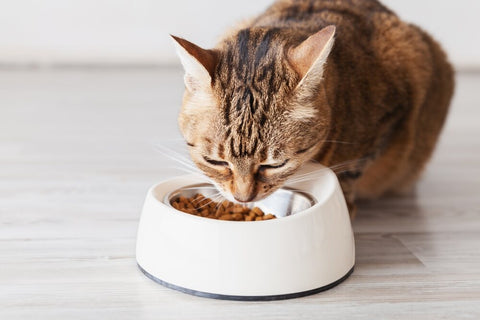Diet is a major factor in your feline friend’s health and happiness. You want to make sure your cat is enjoying mealtime while also getting the proper nutrients they need to live a full and healthy life!
You may be considering changing your cat's food to improve their overall nutrition, address a specific health concern, or simply introduce more variety to their meals. But no matter the case, it’s best to tread carefully when making this shift.
While changing cat food can be beneficial, there are steps to take that can ensure a smooth transition for your pet along the way. Read on to learn the essential steps for changing a cat’s food.
How to Change Your Cat’s Food Gradually
It is completely okay to change a cat’s food for a variety of reasons! However, you don’t want to suddenly change your cat’s food. Here are the steps you can take for a gradual transition.
1. Consult with a Veterinarian
First things first, consider why you want to change your cat’s diet. Your veterinarian is a great resource who can provide insights and suggestions based on your cat's specific health needs, age, and any allergies or sensitivities. For instance, they may recommend cat food for allergies if they notice your cat has chronic itchy skin and inflammation.
Even if you simply want to add more variety to your cat’s diet or have a picky eater on your hands, it can still be beneficial to talk to your veterinarian about which diet is best for your pet.
2. Choose a New Diet
Of course, the key step in changing your cat’s dry food is choosing a replacement. We recommend choosing a Ch high-quality cat food that delivers the nutrients that your cat requires. It's also essential to select a food that is appropriate for your cat's age and health profile.
For instance, most senior cat diets are less calorie-dense than diets for kittens or adult cats. However, there are currently no specifically established nutrient requirements for cat food, so it is best to seek out personalized dietary advice from your veterinarian.
3. Read the Transition Guidelines
Most cat food brands provide guidelines on transitioning to their product. Simply Naked Pet Food recommends a transition that lasts 7 to 10 days. Mixing your current food with their new food during this time can help the transition go smoothly.
Other types of food can vary, so it’s important to read these instructions carefully to understand the recommendations for changing your cat's food.
4. Make a Plan for Gradual Change
With the guidelines for switching your cat’s food in mind, it’s a good idea to make a plan for this gradual change. Veterinarians recommend switching a cat’s food over time to avoid making his or her stomach upset from a quick change.
5. Mix Old and New Food
The other part of this transition is slowly increasing the amount of new food and decreasing the amount of old food. The Simply Naked timeline for feeding your cat fish-first food goes like this:
- Day 1 through 3: 25% Simply Naked & 75% Old Food
- Day 4 through 7: 50% Simply Naked & 50% Old Food
- Days 8 through 10: 75% Simply Naked & 25% Old Food
- Day 11: 100% Simply Naked
As you can see, you only start with a small amount (25%) of new food on the first day. This transition helps avoid any gastrointestinal issues and makes the change less jarring for your pet.
6. Monitor Your Cat's Reaction
Watch your cat for any adverse reactions to their new food. Since every cat is unique, this timeline can look different for everyone. Constipation, diarrhea, vomiting, and gas could occur during this transition. If any of those happen, simply slow things down.
Also, take notice of your cat’s skin and coat during this time. Itchy, irritating skin problems are the most common signs of a food allergy in cats.
7. Maintain a Consistent Feeding Schedule:
Consistency is key when changing cat food. Cats thrive on routine anyway, so try to feed them at the same times each day.
A consistent feeding schedule can help your cat adjust to the new food. At the same time, it also allows you to observe any appetite or behavior changes during feeding times that might indicate that the diet isn’t ideal or the transition needs to be more gradual.
8. Be Patient
Oftentimes, the best way to change a cat’s diet is to let your pet take the lead. Too much change too fast can make mealtime an unpleasant experience for your cat. Go at their pace for the best results.
9. Complete the Transition
Eventually, your cat should be eating 100% of the new food! This transition period may vary depending on your cat's individual preferences and tolerance. By now, 100% of the food offered should be from his or her new diet.
More Tips for Changing a Cat’s Food

Along with these steps, there are other important considerations when changing a cat’s food. Perhaps the most important is ensuring your cat always has access to fresh, clean water. Proper hydration is key for your cat’s overall health, but especially during a diet transition.
You also want to keep in mind the food you are trying to switch. These steps can be used for changing from one type of food to another, such as going from wet food to dry food. However, mixing wet and dry food doesn’t always work out (and creates a consistency that many cats don’t like). Simply serve wet and dry food in separate bowls during the transition to avoid this.
Ready to make the change to a more nutritious and balanced diet for your cat? Browse our selection of irresistible dry cat food that’s packed with the Power of Vitamin Sea!



